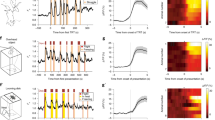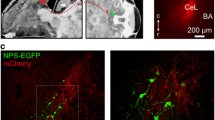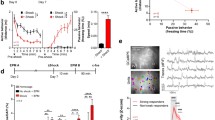Abstract
The ventral part of the anteromedial thalamic nucleus (AMv) is in a position to convey information to the cortico-hippocampal-amygdalar circuit involved in the processing of fear memory. Corticotropin-releasing-factor (CRF) neurons are closely associated with the regulation of stress and fear. However, few studies have focused on the role of thalamic CRF neurons in fear memory. In the present study, using a conditioned fear paradigm in CRF transgenic mice, we found that the c-Fos protein in the AMv CRF neurons was significantly increased after cued fear expression. Chemogenetic activation of AMv CRF neurons enhanced cued fear expression, whereas inhibition had the opposite effect on the cued fear response. Moreover, chemogenetic manipulation of AMv CRF neurons did not affect fear acquisition or contextual fear expression. In addition, anterograde tracing of projections revealed that AMv CRF neurons project to wide areas of the cerebral cortex and the limbic system. These results uncover a critical role of AMv CRF neurons in the regulation of conditioned fear memory.





Similar content being viewed by others
References
Aggleton JP, Hunt PR, Nagle S, Neave N. The effects of selective lesions within the anterior thalamic nuclei on spatial memory in the rat. Behav Brain Res 1996, 81: 189–198.
Taube JS. Head direction cells recorded in the anterior thalamic nuclei of freely moving rats. J Neurosci 1995, 15: 70–86.
Byatt G, Dalrymple-Alford JC. Both anteromedial and anteroventral thalamic lesions impair radial-maze learning in rats. Behav Neurosci 1996, 110: 1335–1348.
Carvalho-Netto EF, Martinez RCR, Baldo MVC, Canteras NS. Evidence for the thalamic targets of the medial hypothalamic defensive system mediating emotional memory to predatory threats. Neurobiol Learn Mem 2010, 93: 479–486.
de Lima MA, Baldo MVC, Canteras NS. Revealing a cortical circuit responsive to predatory threats and mediating contextual fear memory. Cereb Cortex 2019, 29: 3074–3090.
Gross CT, Canteras NS. The many paths to fear. Nat Rev Neurosci 2012, 13: 651–658.
Marchand A, Faugere A, Coutureau E, Wolff M. A role for anterior thalamic nuclei in contextual fear memory. Brain Struct Funct 2014, 219: 1575–1586.
Conejo NM, González-Pardo H, López M, Cantora R, Arias JL. Induction of c-Fos expression in the mammillary bodies, anterior thalamus and dorsal hippocampus after fear conditioning. Brain Res Bull 2007, 74: 172–177.
de Lima MA, Baldo MVC, Canteras NS. A role for the anteromedial thalamic nucleus in the acquisition of contextual fear memory to predatory threats. Brain Struct Funct 2017, 222: 113–129.
Merchenthaler I, Vigh S, Schally AV, Stumpf WE, Arimura A. Immunocytochemical localization of corticotropin releasing factor (CRF)-like immunoreactivity in the thalamus of the rat. Brain Res 1984, 323: 119–122.
Bale TL, Vale WW. CRF and CRF receptors: role in stress responsivity and other behaviors. Annu Rev Pharmacol Toxicol 2004, 44: 525–557.
Henckens MJ, Deussing JM, Chen A. Region-specific roles of the corticotropin-releasing factor-urocortin system in stress. Nat Rev Neurosci 2016, 17: 636–651.
Swaab DF, Bao AM, Lucassen PJ. The stress system in the human brain in depression and neurodegeneration. Ageing Res Rev 2005, 4: 141–194.
Wang SS, Yan XB, Hofman MA, Swaab DF, Zhou JN. Increased expression level of corticotropin-releasing hormone in the amygdala and in the hypothalamus in rats exposed to chronic unpredictable mild stress. Neurosci Bull 2010, 26: 297–303.
Koob GF, Bloom FE. Corticotropin-releasing factor and behavior. Fed Proc 1985, 44: 259–263.
Chen P, Lou S, Huang ZH, Wang Z, Shan QH, Wang Y, et al. Prefrontal cortex corticotropin-releasing factor neurons control behavioral style selection under challenging situations. Neuron 2020, 106: 301–315 e7.
Sanford CA, Soden ME, Baird MA, Miller SM, Schulkin J, Palmiter RD, et al. A central amygdala CRF circuit facilitates learning about weak threats. Neuron 2017, 93: 164–178.
Wehner JM, Radcliffe RA. Cued and contextual fear conditioning in mice. Curr Protoc Neurosci 2004, Chapter 8: Unit8 5C.
Taniguchi H, He M, Wu P, Kim S, Paik R, Sugino K, et al. A resource of cre driver lines for genetic targeting of GABAergic neurons in cerebral cortex. Neuron 2011, 71: 995–1013.
Hou XH, Hyun M, Taranda J, Huang KW, Todd E, Feng D, et al. Central control circuit for context-dependent micturition. Cell 2016, 167: 73–86 e12.
Wamsteeker Cusulin JI, Fuzesi T, Watts AG, Bains JS. Characterization of corticotropin-releasing hormone neurons in the paraventricular nucleus of the hypothalamus of Crh-IRES-Cre mutant mice. PLoS One 2013, 8: e64943.
Konsman JP. The mouse brain in stereotaxic coordinates: Second Edition (Deluxe) By Paxinos G and Franklin KBJ. Academic Press, New York, 2001. Psychoneuroendocrinology 2003, 28: 827–828.
Ni RJ, Shu YM, Luo PH, Fang H, Wang Y, Yao L, et al. Immunohistochemical mapping of neuropeptide Y in the tree shrew brain. J Comp Neurol 2015, 523: 495–529.
Olschowka JA, O’Donohue TL, Mueller GP, Jacobowitz DM. Hypothalamic and extrahypothalamic distribution of CRF-like immunoreactive neurons in the rat brain. Neuroendocrinology 1982, 35: 305–308.
Gray TS. Amygdaloid CRF pathways. Role in autonomic, neuroendocrine, and behavioral responses to stress. Ann N Y Acad Sci 1993, 697: 53–60.
Erb S, Salmaso N, Rodaros D, Stewart J. A role for the CRF-containing pathway from central nucleus of the amygdala to bed nucleus of the stria terminalis in the stress-induced reinstatement of cocaine seeking in rats. Psychopharmacology (Berl) 2001, 158: 360–365.
Beck CH, Fibiger HC. Conditioned fear-induced changes in behavior and in the expression of the immediate early gene c-fos: with and without diazepam pretreatment. J Neurosci 1995, 15: 709–720.
Canteras NS, Pavesi E, Carobrez AP. Olfactory instruction for fear: neural system analysis. Front Neurosci 2015, 9: 276.
Fendt M, Koch M, Schnitzler HU. Corticotropin-releasing factor in the caudal pontine reticular nucleus mediates the expression of fear-potentiated startle in the rat. Eur J Neurosci 1997, 9: 299–305.
Skórzewska A, Bidziński A, Hamed A, Lehner M, Turzyńska D, Sobolewska A, et al. The effect of CRF and α-helical CRF(9–41) on rat fear responses and amino acids release in the central nucleus of the amygdala. Neuropharmacology 2009, 57: 148–156.
Yehuda R, LeDoux J. Response variation following trauma: a translational neuroscience approach to understanding PTSD. Neuron 2007, 56: 19–32.
Senn V, Wolff SB, Herry C, Grenier F, Ehrlich I, Gründemann J, et al. Long-range connectivity defines behavioral specificity of amygdala neurons. Neuron 2014, 81: 428–437.
Dejean C, Courtin J, Rozeske RR, Bonnet MC, Dousset V, Michelet T, et al. Neuronal circuits for fear expression and recovery: recent advances and potential therapeutic strategies. Biol Psychiatry 2015, 78: 298–306.
Klavir O, Prigge M, Sarel A, Paz R, Yizhar O. Manipulating fear associations via optogenetic modulation of amygdala inputs to prefrontal cortex. Nat Neurosci 2017, 20: 836–844.
Burgos-Robles A, Kimchi EY, Izadmehr EM, Porzenheim MJ, Ramos-Guasp WA, Nieh EH, et al. Amygdala inputs to prefrontal cortex guide behavior amid conflicting cues of reward and punishment. Nat Neurosci 2017, 20: 824–835.
Fanselow MS, Gale GD. The amygdala, fear, and memory. Ann N Y Acad Sci 2003, 985: 125–134.
Davis M. The role of the amygdala in fear and anxiety. Annu Rev Neurosci 1992, 15: 353–375.
Swanson LW, Köhler C, Björklund A. The limbic region. I. The septohippocampal system. In: Björklund A, Hökfelt T, Swanson LW (eds) Handbook of chemical neuroanatomy, vol 5. Integrated systems of the CNS, part I. Elsevier, 1987: 125–277.
Ding SL. Comparative anatomy of the prosubiculum, subiculum, presubiculum, postsubiculum, and parasubiculum in human, monkey, and rodent. J Comp Neurol 2013, 521: 4145–4162.
Hunsaker MR, Kesner RP. Dissociations across the dorsal–ventral axis of CA3 and CA1 for encoding and retrieval of contextual and auditory-cued fear. Neurobiol Learn Mem 2008, 89: 61–69.
Acknowledgements
This work was supported by the National Natural Science Foundation of China (32000716 and 91732304), and the Strategic Priority Research Program of the Chinese Academy of Sciences (XDB02030001).
Author information
Authors and Affiliations
Corresponding authors
Ethics declarations
Conflict of interest
The authors declare that there are no conflict of interest.
Electronic supplementary material
Below is the link to the electronic supplementary material.
Rights and permissions
About this article
Cite this article
Lv, Y., Chen, P., Shan, QH. et al. Regulation of Cued Fear Expression via Corticotropin-Releasing-Factor Neurons in the Ventral Anteromedial Thalamic Nucleus. Neurosci. Bull. 37, 217–228 (2021). https://doi.org/10.1007/s12264-020-00592-6
Received:
Accepted:
Published:
Issue Date:
DOI: https://doi.org/10.1007/s12264-020-00592-6




